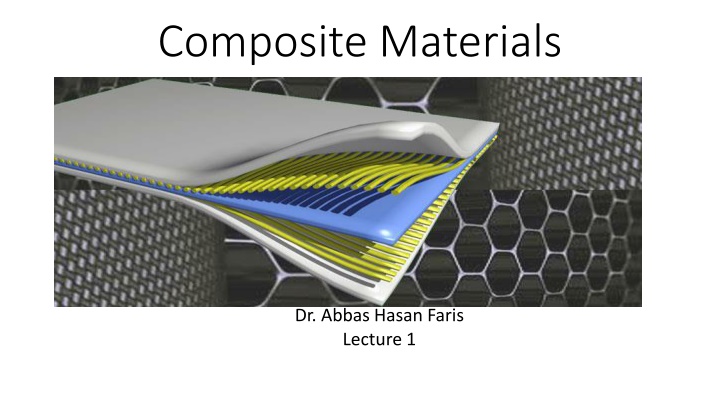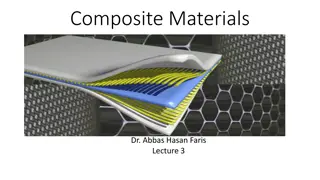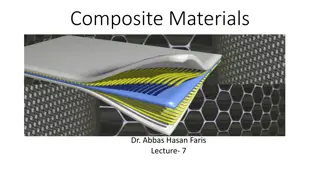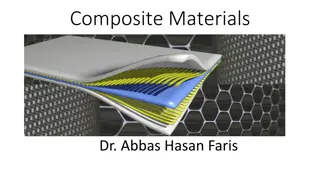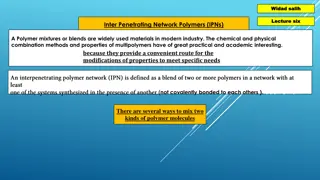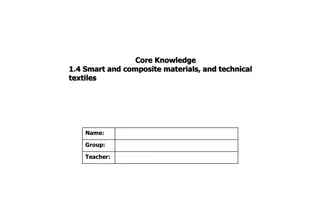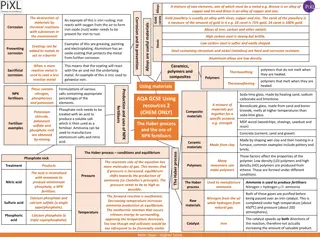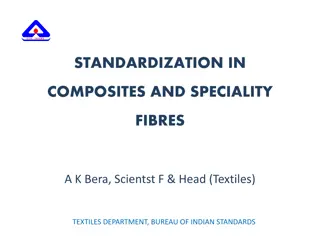Introduction to Composite Materials
Composite materials play a vital role in technological development, offering advanced solutions for various industries. This lecture covers topics such as the analysis of laminas, mechanical properties, manufacturing technology, and more. Discover the significance of composite materials in enhancing structural integrity and performance under diverse conditions.
Download Presentation

Please find below an Image/Link to download the presentation.
The content on the website is provided AS IS for your information and personal use only. It may not be sold, licensed, or shared on other websites without obtaining consent from the author.If you encounter any issues during the download, it is possible that the publisher has removed the file from their server.
You are allowed to download the files provided on this website for personal or commercial use, subject to the condition that they are used lawfully. All files are the property of their respective owners.
The content on the website is provided AS IS for your information and personal use only. It may not be sold, licensed, or shared on other websites without obtaining consent from the author.
E N D
Presentation Transcript
Composite Materials Dr. Abbas Hasan Faris Lecture 1
CHE 3322 Composite Materials Instructor: Dr. Abbas Hsan Faris Office: Email: abbashasan@uoanbar.edu.iq Course Credits: 2 Chem. & Petrochemical Dept. Building .2ndfloor. Room No. 3
Course Content: Introduction Definition classification behaviors of unidirectional composites Analysis of lamina; constitutive classical laminate theory, thermal stresses, Classification of reinforcement, Type of fibers, Factors effect of fibers, Mechanical properties of composites, Manufacturing technology, Nano Technology Micromechanics Factors influencing strength and stiffness failure modes, Performance under adverse environment Prediction of strength, stiffness
Reference Books/Material: Composite Materials, Science and Engineering by Krishan K. Chawla Composite Materials and Applications by Daniel Gay, Suong V. Hoa, Stephen W. Tsai Any other book on composite materials Research papers
Grading Policy: First Exam: 25% Second Exam: 25% Assignments: 10% (Individual + Group) Absolute 30% for passing. Relative grading after that. Assignments should be submitted on the due date, Late submission and copying will be heavily penalized! Attendance will be monitored regularly.
Introduction Composite materials It is an obvious fact technological development depends on advances in the field of materials. One does not have to be an expert to realize that the most advanced turbine or aircraft design is of no use if adequate materials to bear the service loads and conditions are not available. Whatever the field may be, the final limitation on advancement depends on materials. Composite materials in this regard represent nothing but a giant step in the ever-constant work of improving materials.
The idea of composite materials is not a new or recent one. Nature is full of examples wherein the concept of composite materials is used. The coconut palm leaf, for example, is essentially used as a concept of fiber reinforcement. Wood has represented a composite : cellulose fibers in a lignin matrix. The cellulose fibers have high tensile strength but are very flexible (low stiffness), while the lignin matrix joins the fibers and provides the stiffness. Bone is yet another example of a natural composite that supports of various members of the body. It consists of short and soft collagen fibers embedded in a mineral matrix called apatite.
Since the early 1960s, there has been an increasing demand for stiffer and stronger materials yet lighter ones in fields as diverse as aerospace, energy, and civil construction. The demands made on materials to improve overall performance are so great and diverse that no one material can satisfy them. This naturally led to a resurgence of the old concept of combining different materials in an integral-composite material to satisfy the user requirements.
Comparison between conventional monolithic materials and composite materials (1978).
Therefore, we must agree on an operational definition of composite material for our purposes in this text. We shall call a material that satisfies the following conditions a composite material: 1. It is manufactured (i.e., naturally occurring composites, such as wood, are excluded). 2. It consists of two or more phases that are physically and/or chemically distinct, suitably arranged, or distributed with an interface separating them. 3. It should have characteristics that are not depicted by any of the components in isolation.
A composite is a structural material that consists of two or more combined constituents that are combined at a macroscopic level and are not soluble in each other. So that the properties of the composite are different (usually better) from those of the individual constituents. One constituent is called the reinforcing phase and the one in which it is embedded is called the matrix. The reinforcing phase material may be in the form of fibers, particles, or flakes. The matrix phase materials are generally continuous. Examples of composite systems include concrete reinforced with steel and epoxy reinforced with graphite fibers, etc. 11
Applications: Aerospace industry Chemical industries, electrical constructions. Sporting Goods Industry Automotive Industry Home Appliance Industry
The important property that recognizes the composite material on metal is the strength-to-density ratio or strength-to-weight ratio. Composite is made of A- Continuous medium matrix B- Discontinuous medium Reinforcement (which is usually harder and stronger one ) Therefore the properties of the composite depend on the properties of the matrix and reinforcement materials, their distribution, and interaction. Interface: Zone across which matrix and reinforcing phases chemically, physically, and mechanically interact
The simplest composite materials are composed of just two phases. The first is termed the matrix, which is continuous and surrounds the other phase which is often called the dispersed phase (Reinforcement phase). Reinforcement phase (a) there is a change in the concentration of the dispersed (fiber) material. (b) the size of the dispersed phase, (c) the shape, (d) the distribution, and (e) the orientation. All these will affect the final performance of the composite.
